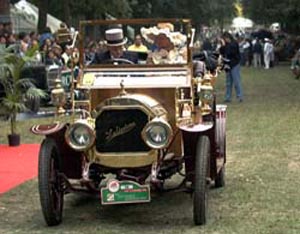|
|
|
|
|
|
|
|
|
|
|
|
|
|
|
|
|
|
|
|
|
|
|
|
|
|
|
|
|
|
|
|
|
|
|
|
|
|
|
|
|
|
|
|
|
|
|
|
 |
The story of "La Société française des Automobiles Corre" in 1901 at Levallois (near Paris) after one year of racing for the founder J.CORRE, and continues to 1949
|
|
|
|
|
|
|
|
|
|
|
|
|
The importance of LA LICORNE at the beginning of the century can be measured by the number of pages in "L'Autocatalogue" ranking all the trademarks, that is to say a little less than Renault, Peugeot, De Dion Bouton and Panhard.
|
|
|
|
|
|
|
|
In 1903 after some race victories J.Corre's cars begin to be "mass-produced".
|
|
|
Several models are built and sold until 1936 under the name of Corre. When M. Corre leaves the factory, the trademark is renamed Corre-La Licorne
|

|
The range is made up of a 2 cylinder (1727 cm3) and a 4 cylinder 15/20 HP. The car, powered by a De Dion of 8 HP, is produced until 1912. After this date, all the Corré are powered by a 4 cylinder. No less than 9 models (from 7 to 25 HP) are available in 1914.
|
|
|
|
|
|
After the first world war , the workshops move to Neuilly and the new model shown in 1919 is powered by a Ballot (1244 cm3) without valves.
|
|
|
|
|
|
|
|
|
|
|
|
|
 |
|
|
 |
|
|
|
|
|
|
|
During the 1920s, the company has several models including one Ballot, 9/12 HP, 1692 cm3, the 12/15 HP, 2997 cm3 and a car powered by a SCAP 8/10 HP, 1393 cm3.
|

|
In 1926 the "Compagnie Française des voitures Corre La Licorne" already has a great variety of cars, but also very strong little trucks and a
much appreciated delivery truck named "normande" powered by a untiring 4 cylinder Ballot.
|
|
|
|
|
|
|
|
|
|
|
|
|
|
In 1927 a 6 cylinder (1492 cm3) is created, and makes La Licorne win a lot of race victories. The workshops move to Courbevoie and build car with Citroën's chassis.
|
|
|
|
|
|
|
|
|
|
|
|
|
|
|
|
 |
|
 |
|
|
|
|
|
|
|
The greatest years of La Licorne begin in 1927 with the creation of the 5 and 6 HP and continue until 1937. They are the first models to be entirely built at Courbevoie on a very good chassis. The reason is that most of La Licorne engine producers disappeared (De Dion Bouton next Chapuis-Dornier, Ballot and Scap) due to the expansion of other manufacturers.
|
 |
|
|
|
 |
The 5 HP H02 arrives at the good time to replace the 5 CV Citroën and also the Renault NN finishing their career with a "too light" 5 HP Peugeot. The target is to offer four large seats on a simple and strong chassis for a low price and good performance.
|
|
|
|
 |
The first car shown at the "Salon" in 1927 becomes a great success. The 905 cm3 engine was started with a Dynastart and cooled using a thermostat. The Solexcarburettor wasfed by a 27 litres petrol tank. The engine had 3 gears and a mono-disc clutch. The driver's seat is on the right to show that it is a luxurious car.
|
 |
|
|
|
|
|
|
|
In May 1931, the 6/8 HP L04 appears. The price is nearly the same as the one with 5 HP, but it has more quality.
The engine is an 1125 cm3 now, and the combustion chambers are treated to avoid distortion. The rubber part between the engine and the Dynastart combined to the Celeron pinion make the car more silent. The carburettor is the same but a Delco is used instead of a magneto.
|
 |
|
|
|
|
|
|
|
|
|
|
|
|
|
|
|
 |
|
|
|
|
|
|
|
|
|
|
|
|
|
|
At the beginning of World War Two, two new cars are shown, but it is too late, La Licorne begins it's decline.
A very interesting electrical prototype was built but:
In 1949 after a last cabriolet 14 CV prototype shown at the "Salon de l'Auto" the workshops close permanently.
|
|
|
|
|
|
|
|
|
|
|
Corre has built approxymatly 1.100 cars from 1901 to 1906 and
La Licorne has built 30.000 cars from 1907 to 1949
|
|
|
|